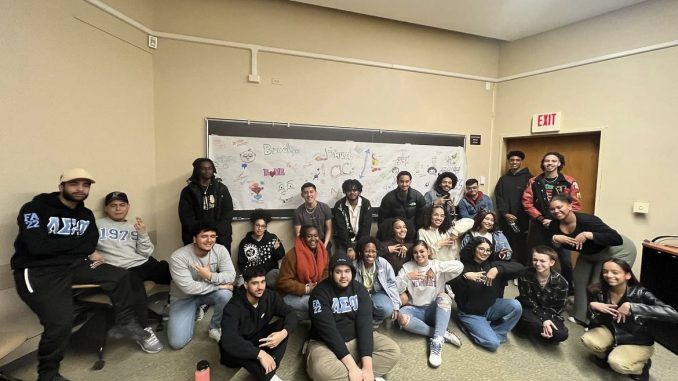
On Wednesday March 22, the Caribbean Latin Coalition (CLC) welcomed students for a discussion around the increasing amounts of gentrification in New York through the lens of street art. Their event “Reclaiming Our Hood” was hosted in Lecture Center Room 109 by club event coordinators Adriana Reyes, a third-year painting and drawing major, and fourth-year political science major and treasurer of the club Kacey Manzueta. The CLC is a club here at SUNY New Paltz that is dedicated to uplifting Caribbean and Latin students. “The purpose of CLC is to create a safe space for Latin and Caribbean students and anybody. We just want to educate people on our culture, how we can spread our culture and celebrate it,” Manzueta stated. “We do programs to basically teach and also just create a better bond with the students on campus.”
The event began with a presentation by Reyes and Manzueta talking about gentrification and the shifts they have seen in their own communities and neighborhoods back home in New York City. The two explained how gentrification is the process in which low income areas shift socioeconomically due to an influx of wealthier people and businesses. This can typically be seen by larger corporations taking over smaller “mom and pop shops,” or buying affordable housing and turning them into condos. Other effects on changing these communities are the displacement of previous residents and businesses due to the growing costs of living in the area, as well as the loss of community that comes from these people leaving.
Changes in communities that have their own rich cultural identities become lost. Many students who attended the event felt connected because they also came from similar neighborhoods. John Duran, a second-year finance major told The Oracle, “My favorite part of the event is that it gives light to our communities back at home. So you know, everyone learns about what’s going on in the community and how they can give back or prevent such things from happening.”
The presentation also discussed actions communities have taken in order to prevent gentrification, such as remaining mindful of one’s engagement and participation in their community. People can also stay on top of local elections, go to town halls to voice concerns and support local businesses to mitigate rising issues.
Public works of art were a recurring theme in the presentation when discussing ways to bring attention and awareness. Street art is a particular mode of expression of ideas and beliefs used in the Caribbean and Latin communities. Not only does street art mark people’s cultures and memorialize it, the art helps spread a message. Reyes explained that “having the opportunity to really explore social justice through the use of art is something that’s very, very important to me. I consider myself a political artist, and somebody that wants to utilize my work and platform as a way to really talk about issues that you don’t see in gallery spaces.”
Chris Tavera, a third-year finance major, told The Oracle, “My favorite part of the event was the wall piece that we got to do. We get to put our art into something and to be able to display this for a large general public to see. I think that it’s something that’s very educational to people, especially about a topic about gentrification.” After the presentation was held, Reyes and Manzueta invited attendees to participate in creating their own street art-inspired mural that will be showcased in the clubs on campus museum El Museo Escolar. Reyes explained that the items on display “consist of mostly all donated artifacts, like things from the Caribbean and Latin communities that the club itself has amassed over the last 50 years or so.”
On March 24, the CLC announced to the club’s Instagram, @elmuseonp, “The school wants to take away our museum and only have a general space for all clubs.”
In response, the CLC created a petition informing the general public of the situation. The post mentions how the school’s new policy would be stripping the campus of an important cultural space and would be inherently “grouping” people together.
Manzueta said, “Being able to have an effect on a predominantly white campus is really nice. Being able to speak about things that really matter to me and to my community is nice. I feel like I never thought I’d be doing this.” The petition to preserve El Museo Escolar gathered over 1,000 signatures.
After seeing the campus wide support, the school reversed their initial decision. In an Instagram post published on March 29, the CLC announced that not only will the school be granting the club back their space, but there will be continuous efforts to “recognize it as an established museum on campus.”
“On behalf of the Caribbean Latin Coalition, we would like to begin by extending a huge thank you to those that lent a helping hand,” the post read. “We cannot express our gratitude enough. We would not be US without YOU.”
